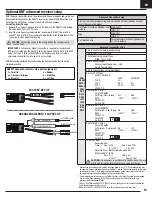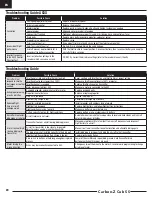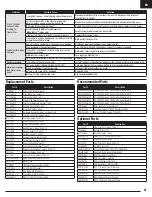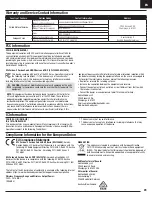
EN
17
Flying Tips and Repairs
Consult local laws and ordinances before choosing a flying location.
Flying Field
Always choose a wide-open space for flying your aircraft. It is ideal for you to fly
at a sanctioned flying field. If you are not flying at an approved site, always avoid
flying near houses, trees, wires and buildings. You should also be careful to avoid
flying in areas where there are many people, such as busy parks, schoolyards, or
soccer fields.
Range Check your Radio System
Before you fly, range check the radio system. Refer to your specific transmitter
instruction manual for range test information.
Understanding Oscillation
Once the AS3X system is active (after advancing the throttle for the first time), you
will normally see the control surfaces react to aircraft movement. In some flight
conditions, you will see oscillation. If oscillation occurs, decrease airspeed. If oscil-
lation persists, refer to the Troubleshooting Guide for more information.
Takeoff
Place the aircraft in position for takeoff (facing into the wind). Set your transmitter
in low rate and gradually increase the throttle to ¾ to full and steer with the rudder.
Pull back gently on the elevator and climb to a comfortable altitude.
Flying
Fly the airplane and trim it for level flight at ¾ throttle. After landing, adjust the
linkages mechanically to account for trim changes, then reset the trims to neutral.
Ensure the aircraft will fly straight and level with no trim or sub-trim.
TIP
If using more than 8 clicks of flight trim, mechanically adjust the linkage so
less trim is needed, or AS3X operation may be affected.
Landing
For your first flights and with the recommended battery pack (SPMX40006S50),
set your transmitter timer or a stopwatch to 7 minutes. Adjust your timer for longer
or shorter flights once you have flown the model. When the motor pulses, land the
aircraft immediately and recharge the flight battery. It is not recommended to fly
the battery to LVC.
Make sure to land into the wind. Fly the aircraft to approximately 36 inches
(90 cm) or less above the runway, using a small amount of throttle for the entire
descent. Keep the throttle on until the aircraft is ready to flare. During flare, keep
the wings level and the aircraft pointed into the wind. Gently lower the throttle
while pulling back on the elevator to bring the aircraft down on its wheels.
NOTICE:
If a crash is imminent, reduce the throttle and trim fully. Failure to do so
could result in extra damage to the airframe, as well as damage to the ESC and
motor.
NOTICE:
After any impact, always ensure the receiver
is secure in the fuselage. If you replace the receiver, install the new receiver in
the same orientation as the original receiver or damage may result.
NOTICE:
Crash damage is not covered under warranty.
Flaps
When using flaps, takeoffs and landings are shorter. When taking off, the tail will
come off the ground quicker for better rudder control during the takeoff roll.
During landing, the flaps allow a landing approach to be steeper with the ability to
use more throttle. Flaps make the plane come in at a slower airspeed
and make it easier to flare and settle in for a smooth landing.
When deploying the flaps, slow the aircraft down to 1/4 throttle. If the flaps
are deployed when the aircraft is at a higher speed, the aircraft will pitch up.
Set your down elevator to flap compensation according to the Transmitter Setup
Chart to reduce the pitch up tendency.
NOTICE:
When using flaps with this airplane, down elevator to flap mixing is
required. Failure to do so may result in loss of control or a crash.
Water Takeoff and Landing Using the Optional Float Set
Only use the floats if you are comfortable flying your aircraft and have
repeatedly taken off, flown and landed with success. Flying off water poses a
higher risk to the airplane because the electronics can fail if fully immersed in
water.
Always ensure the optional floats (EFLA5600 (floats) and EFL12419 (float Struts),
sold separately) are secure on the fuselage and that the float rudder linkage is cor-
rectly connected and moves freely before putting the aircraft in water.
To take off from water, steer with the rudder to face into the wind and slowly in-
crease the throttle. Keep the wings level on takeoff. Hold a small amount (1/4–1/3)
of up elevator and the aircraft will lift off once flying speed is reached. Avoid rapidly
increasing the throttle as torque from the motor may cause the aircraft to roll
to the left when on water.
To land this aircraft on water, fly the aircraft to a couple of feet off the surface
of the water. Reduce throttle and add up elevator to flare the aircraft.
When taxiing, you must use throttle to move the aircraft forward, but steer with
the rudder stick. The stick will turn both the aircraft rudder and a small rudder
attached to the left float.
Avoid taxiing cross wind if there is a breeze, as this can cause the aircraft to
flip over if wind gets under the upwind wing. Taxi 45 degrees into the direction
of the wind (not perpendicular to the wind) and use aileron to hold the upwind
wing down. The aircraft will naturally try to face into the wind when taxiing.
Always fully dry the aircraft after landing on water.
Wind
NOTICE:
When you are finished flying, never leave the airplane in direct sunlight
or a hot, enclosed area such as a car. Doing so can damage the foam.
Repairs
Thanks to the Z-Foam
™
material in this aircraft, repairs to the foam can be made
using virtually any adhesive (hot glue, regular CA, epoxy, etc). When parts are not
repairable, see the Replacement Parts List for ordering by item number. For a list-
ing of all replacement and optional parts, refer to the list at the end of this manual.
NOTICE:
Use of CA accelerant on your aircraft can damage paint. DO NOT handle
the aircraft until accelerant fully dries.








































